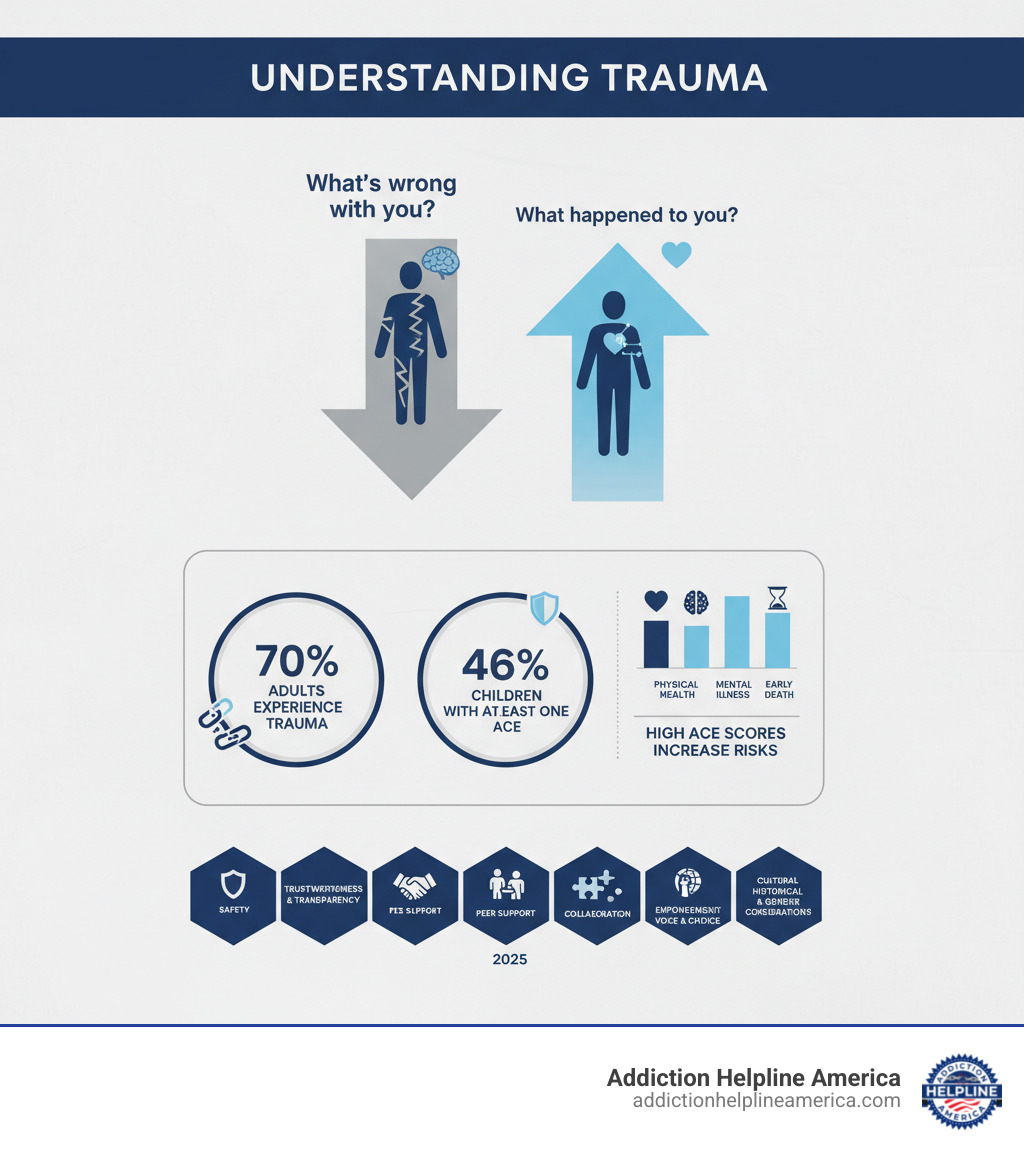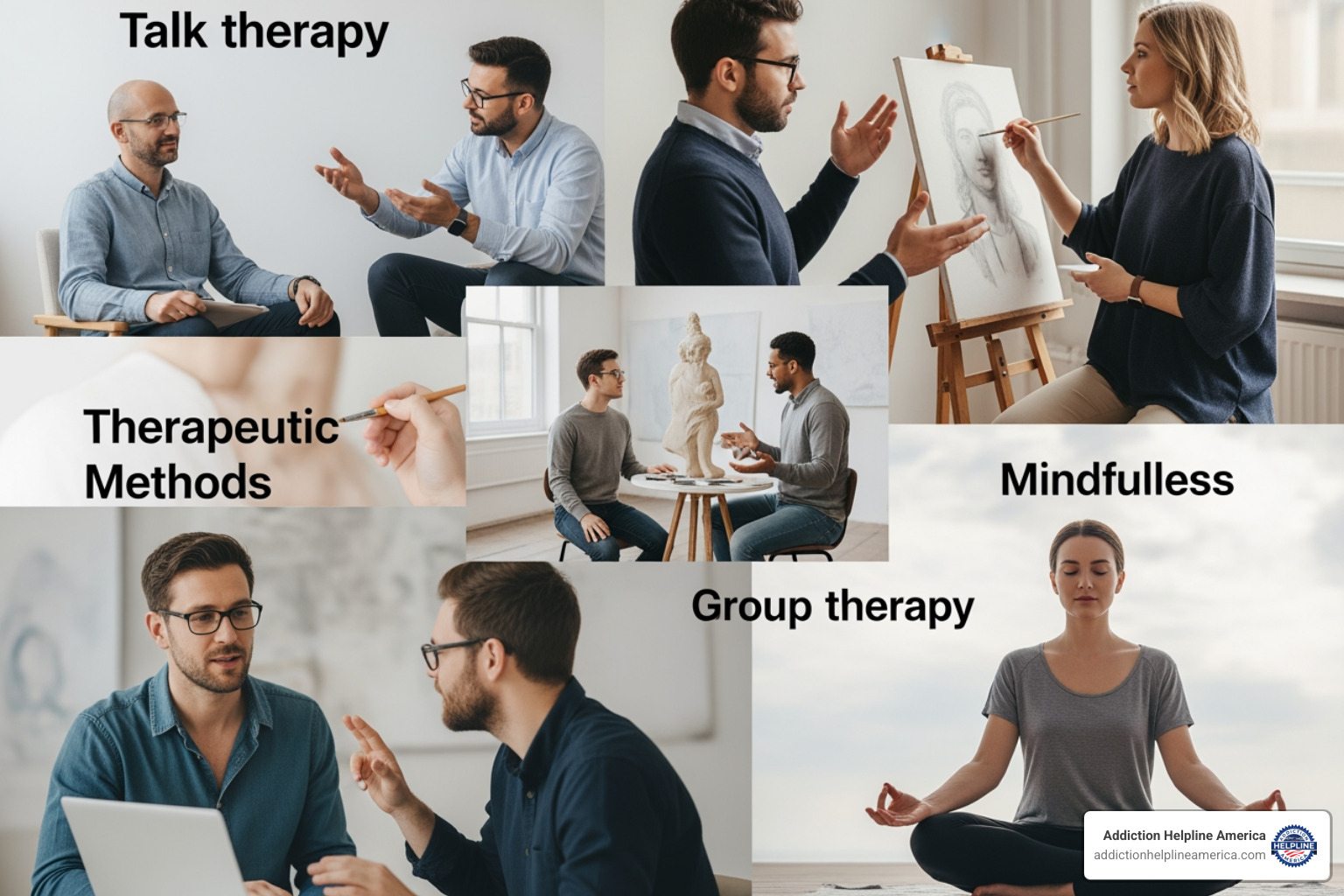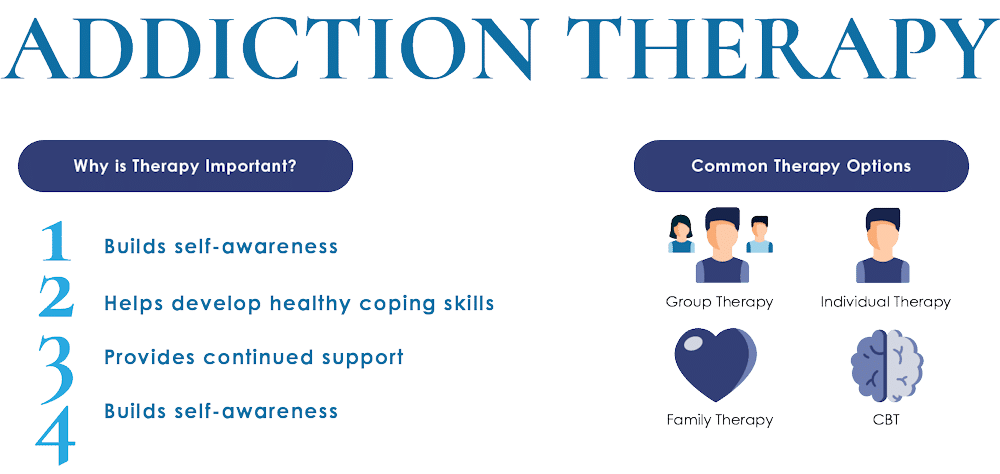
Understanding Trauma-Informed Therapy: A Pathway to Healing
Trauma informed therapy is a mental health approach that shifts the focus from asking “What’s wrong with you?” to “What happened to you?” It recognizes that traumatic experiences can profoundly shape a person’s thoughts, feelings, and behaviors, and that healing requires safety, trust, and empowerment.
This approach helps anyone affected by trauma, from childhood adversity to accidents or ongoing stress. It works by creating a safe therapeutic environment that avoids re-traumatization while addressing the mind-body connection through techniques like CBT, EMDR, and Somatic Experiencing. The benefits include improved emotional regulation, healthier relationships, and long-term healing.
Trauma is more common than many realize. Research shows that more than 46% of children experience at least one Adverse Childhood Experience (ACE), and about 70% of adults encounter trauma in their lives. These events can have lasting effects on mental and physical health.
The good news? Recovery is possible. Trauma-informed therapy acknowledges the widespread impact of trauma and prioritizes creating a safe, respectful environment where individuals are empowered in their own recovery. Unlike traditional therapy that may focus only on symptoms, this approach integrates an understanding of how past trauma affects all aspects of present-day life.
At Addiction Helpline America, we understand the critical link between trauma and addiction. Our team provides compassionate support rooted in trauma informed therapy principles. Our 24/7 helpline connects you with treatment options that prioritize safety, trust, and healing.

Trauma informed therapy definitions:
Understanding Trauma and Its Pervasive Effects
Trauma refers to experiences that overwhelm our ability to cope, leaving lasting marks on how we see ourselves and the world. The DSM-5 defines it as exposure to actual or threatened death, serious injury, or sexual violence. The Substance Abuse and Mental Health Services Administration (SAMHSA) offers a broader view, describing trauma as any event or circumstance that feels physically or emotionally harmful and has lasting negative effects.
Trauma doesn’t look the same for everyone. It can reshape your thoughts, emotions, memory, and sense of self, and it literally changes how your brain and body work together.

Understanding the different types can help you recognize your experiences:
- Acute trauma: Stems from a single event, like an accident or sudden loss.
- Chronic trauma: Develops from repeated, prolonged exposure to stress, such as domestic violence or long-term abuse.
- Complex trauma: Involves multiple traumatic events over time, often starting in childhood, deeply affecting one’s sense of safety and self-worth.
- Racial trauma: The psychological distress caused by experiencing racism, discrimination, and systemic oppression.
- Secondary (or vicarious) trauma: Occurs from exposure to other people’s trauma, common among healthcare workers, therapists, and first responders.
Trauma can manifest as emotional numbness, overwhelming anxiety, hypervigilance (being constantly on alert), flashbacks, and avoidance of certain people or places. The mind-body connection is profound; psychological distress often translates into physical symptoms like chronic headaches, stomach problems, and difficulty sleeping. Your body keeps score.
If you’re struggling with these symptoms, especially if they’ve developed into Post-Traumatic Stress Disorder (PTSD), specialized support can help. More info about PTSD Treatment is available to help you understand your options.
What are Adverse Childhood Experiences (ACEs)?
A major breakthrough in understanding trauma came from the landmark ACE study by the CDC and Kaiser Permanente. This research revealed a direct, measurable link between childhood adversity and health outcomes decades later.
The study identified 10 specific ACEs, including abuse (physical, sexual, emotional), neglect (physical, emotional), and household dysfunction (mental illness, domestic violence, substance abuse, parental separation/divorce, or an incarcerated relative).
Call Now – Your Journey to Recovery Begins Today!

Take the first step towards a healthier life! Call now to connect with our compassionate team and start your recovery journey today. Your path to healing awaits!
Our recovery specialists are available 24/7 to provide support, and all calls are confidential and free. Reach out anytime – we’re here to help!
The findings are sobering: over 46% of children experience at least one ACE. Adults with higher ACE scores face significantly greater risks for physical and mental health problems. This underscores why addressing childhood trauma with trauma informed therapy is so crucial for individual and societal well-being.
Signs You Might Benefit from Trauma-Informed Therapy
You don’t need a PTSD diagnosis to benefit from trauma informed therapy. If past experiences are affecting your present well-being, it may be time to seek support. Common signs include:
- Persistent anxiety and depression: A chronic sense of worry, sadness, or hopelessness that doesn’t lift.
- Relationship and trust issues: Difficulty opening up, maintaining healthy connections, or feeling constantly on guard.
- Self-destructive behaviors: Using substances, self-harm, or other risky activities to cope with overwhelming feelings.
- Feeling disconnected: A sense of detachment from yourself, others, or your surroundings.
- Unexplained physical symptoms: Chronic headaches, stomach issues, or muscle pain without a clear medical cause.
- Intrusive thoughts or flashbacks: Unwanted memories, images, or sensations that bring the past flooding back.
- Hypervigilance: A state of constantly scanning for threats, even in safe environments.
- Difficulty with emotional regulation: Intense mood swings, explosive anger, or feeling overwhelmed by your emotions.
If these signs resonate, know that help is available. If you’re also dealing with anxiety or depression, more info about therapists for depression and anxiety can point you toward additional resources.
What is Trauma-Informed Therapy and How Does It Work?
Trauma informed therapy is an approach to care that starts with a fundamental shift in perspective: from asking “What’s wrong with you?” to “What happened to you?” This change acknowledges that trauma is common and that it deeply affects how people think, feel, and respond to the world.

Unlike traditional therapy that might focus only on symptoms, trauma-informed care takes a holistic approach. It weaves an understanding of trauma’s impact into every interaction. The goal isn’t just to change behaviors but to understand why they developed, often as survival mechanisms. Safety—both physical and emotional—is the absolute priority, as healing cannot happen in an environment of threat or judgment.
The Substance Abuse and Mental Health Services Administration (SAMHSA) outlines this approach with the “4 R’s”: A trauma-informed system Realizes the impact of trauma, Recognizes its signs and symptoms, Responds by integrating this knowledge into all practices, and actively Resists re-traumatization.
The Core Principles of Trauma-Informed Care
SAMHSA identifies six key principles that guide trauma informed therapy and create an environment where healing can begin:
- Safety: Creating physically and emotionally secure environments is the top priority.
- Trustworthiness and Transparency: Operations and decisions are conducted with transparency to build and maintain trust.
- Peer Support: Involving people with shared lived experiences helps validate feelings, reduce isolation, and inspire hope. You can find more info on the importance of support systems.
- Collaboration and Mutuality: Power differences are leveled, and healing is treated as a partnership between the client and provider.
- Empowerment, Voice, and Choice: Clients’ strengths are built upon, and they are given a voice and choice in their own care to help them reclaim a sense of control.
- Cultural, Historical, and Gender Issues: The process acknowledges and addresses biases, stereotypes, and the impact of historical and cultural trauma.
The Role of Collaboration and Empowerment in Trauma-Informed Therapy
In trauma informed therapy, you are the expert on your own life. The therapeutic relationship is a partnership where you and your therapist develop treatment plans and set goals together. This shared decision-making is crucial for restoring the sense of agency that trauma often takes away.
The focus shifts from deficits to building resilience—your innate capacity to heal. You’ll develop practical coping skills to manage distress and regulate emotions. Through this process, self-awareness grows, allowing you to understand how past trauma shows up in your present life without judgment. This understanding creates space for conscious choice. The safe, consistent relationship with a therapist can itself be a powerful healing tool, offering a corrective emotional experience that helps repair damaged attachment patterns and build healthier ways of connecting with others.
Common Techniques and Approaches in Trauma-Informed Care
Trauma informed therapy uses a variety of evidence-based techniques, all applied through a lens of safety and empowerment. There is no single “right” path, and a therapist may use several tools to meet your specific needs.

Foundational elements often include psychoeducation (understanding trauma’s effects on the brain and body), learning emotion regulation skills to manage intense feelings, and practicing grounding techniques to stay present during moments of distress.
Here are some of the most effective evidence-based approaches:

Cognitive and Behavioral Approaches
These methods focus on the connection between thoughts, feelings, and behaviors.
- Trauma-Focused Cognitive Behavioral Therapy (TF-CBT): Highly effective for children and adults, TF-CBT combines trauma education with relaxation skills and cognitive restructuring to challenge distorted thoughts related to the trauma. It often involves creating a trauma narrative to help process and integrate the experience.
- Cognitive Processing Therapy (CPT): This approach focuses on how trauma changes beliefs about safety, trust, control, self-esteem, and intimacy. It helps individuals challenge and modify unhelpful beliefs related to their trauma.
- Exposure-based techniques: Methods like Prolonged Exposure (PE) help reduce the emotional charge of traumatic memories by having individuals gradually revisit them (imaginally) or face trauma reminders (in-vivo) in a safe, controlled therapeutic setting.
- Dialectical Behavior Therapy (DBT): While not exclusively for trauma, DBT skills are invaluable for survivors. It teaches mindfulness, distress tolerance, emotion regulation, and interpersonal effectiveness to manage intense emotions and improve relationships.
You can explore different types of therapy to learn more about these and other approaches.
Somatic and Mind-Body Approaches
Trauma is stored in the body, not just the mind. These approaches help release its physical grip.
- Somatic Experiencing (SE): This gentle approach focuses on bodily sensations to help the nervous system complete self-protective responses (fight, flight, freeze) that were thwarted during the trauma. It helps release pent-up survival energy from the body.
- Mindfulness: This practice teaches you to observe your thoughts, feelings, and sensations in the present moment without judgment. It helps survivors break free from replaying the past or worrying about the future, fostering inner calm and resilience.
- Body-based coping skills: Techniques like deep breathing, progressive muscle relaxation, and conscious movement (yoga, tai chi) help calm the nervous system and reconnect you with your body in an empowering way.
Other Integrated Approaches
Modern trauma treatment integrates insights from neuroscience and attachment theory.
- Internal Family Systems (IFS): This model views the mind as having different “parts” that take on protective roles after trauma. Therapy helps you understand and heal these parts, fostering inner harmony.
- Polyvagal Theory: This theory explains the nervous system’s response to threat. Therapists use these concepts to help clients regulate their autonomic nervous system and move from states of fight, flight, or freeze into a state of calm and social engagement.
- Attachment-informed care: This approach recognizes that trauma often damages our ability to connect with others. The therapeutic relationship itself becomes a safe space to heal relational wounds and build secure attachment patterns.
- Other Interventions: Models like Skills Training in Affective and Interpersonal Regulation (STAIR), Accelerated Resolution Therapy (ART), and the Trauma Recovery and Empowerment Model (TREM) offer specialized skills and processing techniques for trauma survivors.
The Path to Healing: Benefits and Finding the Right Support
Starting on a trauma informed therapy journey is a courageous step toward reclaiming your life. It’s not just about managing symptoms; it’s about building a foundation for lasting change and finding your own resilience.
Key benefits of this approach include:
- Increased self-awareness of how past experiences shape your present.
- Improved emotional regulation skills to manage overwhelming feelings.
- Healthier connections with others through better communication and trust.
- Relief from physical symptoms as trauma stored in the body is processed.
- A path to long-term healing by developing lifelong coping tools.
This approach is especially powerful for healing from complex trauma, as it shifts the focus from shame to compassionate understanding. For those navigating the intertwined struggles of trauma and addiction, integrated treatment is key. You can explore more info about addiction recovery to understand how comprehensive care works.
Call Now – Your Journey to Recovery Begins Today!

Take the first step towards a healthier life! Call now to connect with our compassionate team and start your recovery journey today. Your path to healing awaits!
Our recovery specialists are available 24/7 to provide support, and all calls are confidential and free. Reach out anytime – we’re here to help!
How to Find a Trauma-Informed Therapist
Finding the right therapist is a critical part of your healing. Not all therapists are trained in this specific approach, so it’s important to look for certain qualities.
- Prioritize Safety and Trust: A trauma-informed therapist will be transparent, respect your pace, and make your emotional and physical safety the top priority from the very first interaction.
- Look for Specific Training: Ask about their training and experience with evidence-based trauma modalities like EMDR, TF-CBT, or Somatic Experiencing.
- Trust Your Gut: Research from the American Psychological Association shows the therapeutic relationship is a powerful predictor of success. You should feel heard, respected, and safe.
- Seek a Collaborative Approach: Your therapist should empower you as an active partner in your healing, not act as an expert who will “fix” you.
When consulting potential therapists, ask direct questions like: “What does being trauma-informed mean to you?” and “How do you ensure a client feels safe during trauma work?” Online directories can help you find specialists, and it’s okay to meet with several before choosing one. For more guidance, you can find more info about finding professional help.
For Caregivers and Professionals: Preventing Secondary Traumatic Stress
If you work with or care for trauma survivors, you are at risk for secondary traumatic stress (or vicarious trauma)—the emotional and psychological toll of witnessing others’ pain. Symptoms can mimic direct trauma exposure and include fatigue, anxiety, and emotional numbness.
Preventing burnout is essential for both your well-being and your ability to provide quality care. Key strategies include:
- Self-Care: Prioritize sleep, hobbies, and relaxation.
- Boundaries: Maintain a clear separation between work and personal life.
- Peer Support: Connect with colleagues who understand the unique challenges of this work.
- Professional Supervision: Use regular consultation to process reactions and receive guidance.
Recognizing the signs of secondary stress and taking proactive steps is crucial for sustaining yourself in this vital work.

Frequently Asked Questions about Trauma-Informed Therapy

What is the main difference between trauma therapy and trauma-informed therapy?
This is an important distinction. Trauma therapy (or trauma-focused therapy) refers to specific treatments like EMDR or TF-CBT designed to directly process traumatic memories and reduce symptoms.
Trauma informed therapy is a broader framework or philosophy that guides how all care is delivered. It assumes anyone may have a trauma history and prioritizes creating an environment of safety, trust, and empowerment. A therapist can use trauma-focused techniques within a trauma-informed framework, ensuring the entire process is safe and avoids re-traumatization.
How long does trauma-informed therapy take?
There is no set timeline. The duration of trauma informed therapy varies based on the individual’s needs, the complexity of their trauma history, and their personal goals. It is a client-paced process focused on sustainable healing, not a quick fix. Some people find relief in a few months, while those with complex trauma may benefit from longer-term support. The right timeline is what’s right for you.
Can this approach help with issues other than PTSD?
Yes, absolutely. While highly effective for PTSD, trauma informed therapy is beneficial for a wide range of challenges that are often rooted in unresolved trauma. This includes:
- Anxiety and depression
- Addiction and substance use disorders
- Relationship difficulties and attachment issues
- Emotional numbness or dysregulation
- Chronic physical symptoms with no clear medical cause
- The psychological impact of racial trauma
By addressing the underlying wounds, this approach helps heal the whole person. If you are dealing with PTSD specifically, you can find more info about PTSD treatment, but this therapy offers hope for a much broader range of struggles.
Call Now – Your Journey to Recovery Begins Today!

Take the first step towards a healthier life! Call now to connect with our compassionate team and start your recovery journey today. Your path to healing awaits!
Our recovery specialists are available 24/7 to provide support, and all calls are confidential and free. Reach out anytime – we’re here to help!
Take the First Step Toward Healing
Understanding trauma’s impact is the first step toward reclaiming your story. Trauma informed therapy offers a compassionate, safe, and effective path forward—one that honors your whole person: mind, body, and spirit.
Recovery is possible. With the right support and a therapeutic approach that respects your experiences, you can move beyond survival and into a life of resilience and well-being. You deserve to heal.
If you or someone you love is struggling with the effects of trauma, especially when it’s intertwined with substance use, you don’t have to face it alone. Addiction Helpline America is here to provide confidential, personalized guidance. Our team understands the deep connection between trauma and addiction and is dedicated to connecting people nationwide to treatment centers that use trauma informed therapy.
Taking the first step can feel daunting, but the courage it takes to ask for help is the same courage that will carry you through recovery. Find a drug and substance abuse treatment program today and begin your journey toward healing and renewed hope.
Our helpline is 100%
free & confidential
If you or someone you care about is struggling with drug or alcohol addiction, we can help you explore your recovery options. Don’t face this challenge alone—seek support from us.
Programs
Resources
Will my insurance
cover addiction
treatment?
We're ready to help
Find the best
drug or alcohol treatment
center
Are you or a loved one struggling with addiction? Call today to speak to a treatment expert.
















